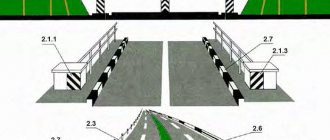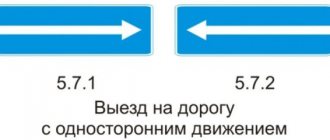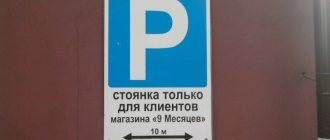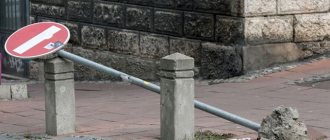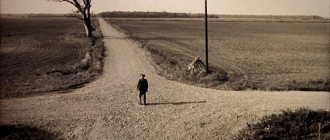If there are signs and markings on the road that contradict each other, then the driver must clearly navigate the situation and know what to give priority to. They may contradict each other in the event of an accident or during repair work on the road. Therefore, the driver must be careful not to create an emergency situation and navigate short-term traffic changes.
What is priority: sign or marking?
In order not to be mistaken with the primacy of signs on the road, you should distinguish between the types of road signs and markings. They can be permanent or temporary. But in any case, according to the rules, the driver must be able to see them at any time of the day. Signs should not be obscured by billboards or trees. Particular attention should be paid to signs that are installed illegally. They have no force and the driver should not take this information into account. Illegal signs include: those attached to a lamp post or tree using duct tape or tape. Such pointers must be ignored.
Temporary road signs and markings
It is easy for a motorist on the road to distinguish temporary road signs from permanent ones. Temporary signs have a yellow background, permanent signs have a white background. According to the traffic rules, there must be a sign under the temporary signs indicating the territory of influence of this informer and the distance to the problem area. Usually, at the end of the segment, sign 3.31 is installed, which removes all restrictions that were in force before it.
The temporary marking differs only in color - it is orange. Temporary indicators always take precedence over permanent ones, since they indicate the need for a certain movement in a specific situation. In this case, stationary signs are usually removed or covered so that they do not confuse drivers. Temporary signs are easier to install and can also be easily dismantled.
Permanent road signs and markings
Permanent signs are installed for a long time. They are designed to show information that will be relevant for a long time, regardless of external factors. Permanent signs must be installed in a specially prepared recess, which is then filled with concrete. Once the concrete has hardened, earth is poured around the sign. Unlike temporary signs, permanent signs inform about the features of movement on a given section of the road in the long term. Permanent markings have a white main background color inside the border.
If there are temporary and permanent informers on the site at the same time, then according to the traffic rules, temporary signs have priority for the driver, since they inform about the changed situation on this section of the road.
Important! If the lines painted on the road contradict the signs, then according to the traffic rules the latter have priority, while the markings are always of secondary importance.
Prioritization
If you prioritize, taking into account temporary and permanent signs, then the temporary road sign comes first, followed by the permanent one. In third place in terms of priorities is temporary marking and only then permanent marking.
On a road that has several lanes, according to traffic regulations, the sign must be located not only on the side, but also on the road so that drivers moving in the middle of the stream have access to this information.
How to sort out priorities?
An understanding of what is more important is provided by traffic rules. But before that, you should take into account some important details, in particular, decide on the types of signs and road markings.
Temporary and permanent signs
For the convenience of road users, today there is a classification of road signs into:
- stationary, or permanent;
- portable, or otherwise temporary.
To distinguish the first category of signs from the second, it is necessary to understand the features of their installation: in order for the stationary sign to be installed correctly, the base of the sign is installed in a pre-prepared recess and filled with concrete mixture. After the concrete has hardened, the area around the base is covered with earth. This type of designation is established for a long time, since the information transmitted by it is always relevant, regardless of other external factors.
The portable type appears only in cases where a situation arises that impedes the movement of traffic flow. Stands with temporary markings are a common occurrence during an accident or road repair. Unlike stationary varieties, portable racks usually have crossed reinforcement at the base, which provides the structure with good stability even in gusts of wind.
A distinctive feature of a temporary indicator from a stationary one is the color of its background: if the symbol is printed on a white base, there is a stationary informer in front of you, but if it is on a yellow one, there is a temporary one.
Illegal signs
There is another type of sign: if suddenly during a trip you notice a sign that will be attached to a tree, lamppost or posts using electrical tape or adhesive tape, just ignore it. Such signs are illegal and therefore have no force.
Temporary and permanent markings
Markings, like sign posts, can also be temporary or permanent, so it is very important to distinguish between these types:
- One of the main goals of the stationary station is to inform motorists about the characteristics of traffic in the specified area in the long term;
- Temporary indicates short-term changes in the nature of movement.
To make it easier for drivers to distinguish one type from another, they are painted in different colors: temporary designations are painted yellow, and stationary ones are painted white.
Situations when two types are simultaneously applied to the road surface are quite rare, but they still happen, which means that when encountering such markings, it is important to know that yellow lines have priority over white ones.
Summarizing the above, you can see that while driving you can find 4 types of elements that take part in organizing movement. Now it’s time to figure out which types are more important.
Examples of contradictions between signs and markings
There are several most common options when the two pointers in question contradict each other. Most often, permission is given to overtake vehicles in the oncoming lane if there is a double solid line and a temporary informer 4.2.2. Usually this combination is used when repairing a road. In this case, the priority will be to allow overtaking, despite the double solid line. There are other options for controversial situations.
Overtaking at sign 3.20 and markings 1.5
Plate 3.20 means that overtaking is prohibited on this section of the road. Marking 1.5 is a broken line allowing overtaking and detour. A broken line is used on two-lane roads as well as on three-lane roads to indicate lanes. Despite the fact that such a line is a “center line,” on two-lane roads it can be crossed and overtaken. But only if there are no additional signs that contradict the lines marked on the road.
If these conflicting information messages are combined on one section of the road, then the driver should not overtake, focusing on the prohibitory sign. But the markings in this case are of particular importance; they allow overtaking or detour:
- slow-moving vehicles;
- horse-drawn transport;
- motorcycles without trailers.
It is the dotted strip that indicates the effect of these exceptions. In this situation, it will not be overtaking, but rather a detour.
Overtaking at sign 3.21 and markings 1.1
The situation is the opposite of the previous one. In this case, symbol 3.21 indicates the end of the overtaking zone, and marking 1.1 is a solid line that cannot be crossed, which means you cannot overtake. In this case, the line will have priority, since the sign does not indicate that overtaking is allowed. It simply indicates the end of the no-overtaking zone. By and large, these informers do not contradict each other, but complement each other.
Important! In bad weather conditions and poor visibility, the driver may not notice the solid line, but will first pay attention exclusively to indicator 3.21. In this case, it is necessary to use regulatory documents to prove the innocence of the motorist.
Common examples of contradictions
Noticing a discrepancy between signs and markings, even an experienced driver can become confused. Such contradictions can cause a serious accident, because a quick reaction is required from the motorist. Therefore, he must set his priorities correctly. Below we will look at common contradictions that arise between markings and signs.
Driving straight and turning
Many motorists have found themselves in the following situation: the sign only allows cars to move straight, but the markings allow them to turn right or left. In this case, turning is prohibited, since the stationary road sign has priority. If it were not there, the driver could turn following the markings.
Driving in the oncoming lane
The following signs may be installed on one section of the road:
- Sign 4.2.2, which allows a motorist to enter the oncoming lane to bypass.
- Double solid line (1.3), which cannot be crossed.
A similar situation often occurs in areas where road work is underway. The driver must follow the sign as it has higher priority.
Overtaking
Sign 3.20 prohibits overtaking. But at the same time, 1.5 markings are applied to the road surface, which allows the driver to enter the oncoming lane. In such situations, the motorist can perform any maneuver except overtaking. He has the right to turn around, turn or go around an obstacle.
In this case, some motorists rely on the markings and commit a serious violation. The fact is that the markings themselves cannot allow overtaking or any other maneuver. It only informs the driver that he can drive into the oncoming lane.
End of No Overtaking Zone sign and solid line
Many motorists think that if the coverage area of sign 3.21 has ended, then they can safely overtake. Even the solid dividing line, which is prohibited to cross, does not stop them. Crossing the 1.1 marking when overtaking is fraught with a fine.
In this situation, there are no contradictions between pointers. Sign 3.21 indicates that the no-overtaking zone has ended. Next, the driver must follow the markings. As soon as the broken line appears, he will be able to perform the maneuver.
What to do if there are contradictions?
First of all, the driver should calm down and not panic. Only in this case will it be possible to make the right decision. If there is an obvious contradiction between the sign and the markings, the priority is always the temporary sign, since it indicates the desired actions depending on specific circumstances (road repairs, accidents, weather conditions, emergency situations). The markings in relation to the sign are always secondary, and this is conveyed to drivers during training at a driving school. It is important to remember this material and use it.
About priorities
Beginning drivers often have the question: “What is more important, the markings or the sign?” To answer this, let's look at the traffic rules. They indicate the following:
- If the sign and markings contradict each other, then the driver must rely on the sign.
- A temporary sign is always more important than a permanent one, since it is installed when the situation on the road changes. Accordingly, as soon as the usual order is restored, the portable sign will be removed.
In modern realities it is impossible to do without the use of temporary pointers. For example, such a sign can be used to organize a detour around an area where road work is being carried out. Portable signs also allow you to inform road users about an accident.
If you arrange the pointers by priority, you get the following list:
- temporary road signs;
- permanent signs;
- temporary marking;
- permanent marking.
Thus, the temporary sign has the highest priority on the road. Where it is installed, the driver must ignore other signs if they contradict the portable sign.
Temporary markings always take precedence over permanent markings. However, it cannot be more important than a permanent sign. Therefore, in places where it is necessary to radically change traffic conditions, it is necessary not only to draw temporary markings, but also to install portable signs.
Responsibility for failure to comply with priorities
If a motorist does not comply with priorities, he faces administrative punishment in the form of a fine. The fee for failure to comply with the requirements of markings or road signs is 500-1500 rubles.
If the sign required you to stop, turn around or turn, the fine increases from 1000 rubles to deprivation of your driver’s license. If the driver believes that he was fined unlawfully and did not violate the priority, then within 10 days he has time to file a complaint and protest the inspector’s decision.
Conflicting information on the road can confuse even experienced drivers. But traffic regulations have clear instructions in this regard: a temporary sign is a priority, since it indicates the necessary actions depending on specific changed road conditions. Most often there is a contradiction with the prohibition and permission of overtaking. If there is a temporary sign on the road prohibiting overtaking, the markings in this case do not matter. It is better for the driver to take his time and not cross the line.
Placement and use of road design elements
Road signs and markings must be placed on the road surface in accordance with traffic rules.
Signs are placed so that they are clearly legible both day and night. They should not be obscured by billboards, trees or other objects.
Road markings must also have good visibility at any time of the day . In places where markings are not visible due to weather conditions or cannot be updated, signs should be installed that carry the relevant information. It is also expected that there will be more duplicate signs on the roads.
In areas where there are several lanes in one direction, it is necessary to install a sign not only on the side, but also above the roadway, on the dividing strip or on the other side of the road. But at the same time, there should be no more than two lanes of traffic in the oncoming direction.
Thus, only road design elements installed in the appropriate order are perceived as traffic rules.
In a normal situation, road signs and markings perfectly complement or repeat each other. But in some situations they may conflict.
It is important to understand the sign or marking, which has priority . In accordance with the new traffic rules, which are still in force in 2021, it follows that any road signs are more important than any markings.
In the first place are temporary road signs, then come permanent ones, after them temporary road markings and at the very end - permanent road markings, which are the least priority.


